Genie Witzel
Genre: Realism
Motifs: Portrait, Landscape
Her Art:
Genie Witzel once regarded herself as a self-taught landscape artist. But that changed when she painted the portrait of General Robert E. Lee that hangs on loan in the County Administrator’s office. “In 2013, the News-Press ran an article about the 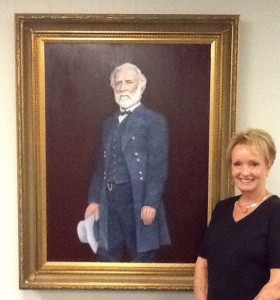 painting of General Lee that hangs in the County Commissioners’ chambers,” Genie relates. “This rather poorly crafted painting of General Lee in full battle regalia has been a sore spot for the African-American community. My friend, Rabbi Bruce Diamond, suggested that I create a less bellicose portrait of Lee, toning down its military theme and offer it as a gift to the county. The painting was still in progress when the chairman of the County Commission told Rabbi Diamond that they would not consider removing the present portrait. Even so, it seemed worthwhile to
painting of General Lee that hangs in the County Commissioners’ chambers,” Genie relates. “This rather poorly crafted painting of General Lee in full battle regalia has been a sore spot for the African-American community. My friend, Rabbi Bruce Diamond, suggested that I create a less bellicose portrait of Lee, toning down its military theme and offer it as a gift to the county. The painting was still in progress when the chairman of the County Commission told Rabbi Diamond that they would not consider removing the present portrait. Even so, it seemed worthwhile to 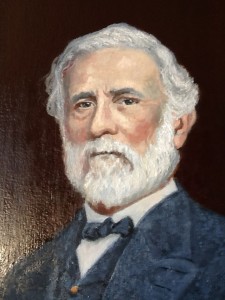 complete [my portrait] since I was very satisfied with its quality.”
complete [my portrait] since I was very satisfied with its quality.”
Witzel’s rendition depicts Lee with remorseful eyes. “For all the men who died on both sides of that war,” Genie explains.” My title for the painting is Hat in Hand, Surrender at Appomattox.”
As a result of her experiences in painting Lee, Marion Twiggs Myers (the woman for whom the eponymous fort was named), Ada Elizabeth Hancock (Fort Myers’ first non-Native American daughter), and Alice Hendry Tooke McCann (Fort Myers’ first switchboard operator), Genie has now “fallen hopelessly in love” with portrait painting. That means that Fort Myers can look forward to seeing lots of new work by this reformed landscape artist.
Portrait of Ada Elizabeth Hancock
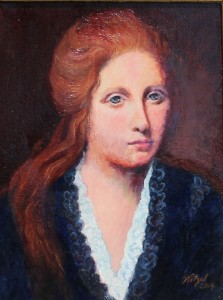 Fort Myers first non-Native American child was a daughter by the name of Ada Elizabeth Hancock. Little Ada was born in 1857 to Captain Winfield Scott Hancock and his wife, Almira, inside the commanding officer’s quarters on the site of what’s now the Sidney & Berne Davis Art Center. Legend also has it that on the day she was born, Captain Hancock planted a date seed in front of the officer’s quarters. The seed sprouted and grew into a tall and magnificent date palm.
Fort Myers first non-Native American child was a daughter by the name of Ada Elizabeth Hancock. Little Ada was born in 1857 to Captain Winfield Scott Hancock and his wife, Almira, inside the commanding officer’s quarters on the site of what’s now the Sidney & Berne Davis Art Center. Legend also has it that on the day she was born, Captain Hancock planted a date seed in front of the officer’s quarters. The seed sprouted and grew into a tall and magnificent date palm.
Ada became the apple of her daddy’s eye. Growing up, she loved to read and her father showered her with the finest literature of the day. But regrettably, Ada died of typhoid fever on March 28, 1875. 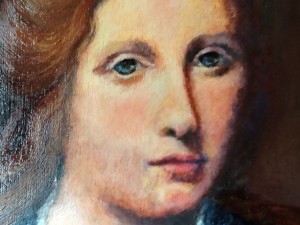 She was barely 19. In Hancock the Superb, author Glenn Tucker reports that “no other loss had ever struck the general such a blow.” General Hancock and his wife returned to Fort Myers several times after that to see the tree because it reminded them of their daughter, and the tree became one of Fort Myers’ most famous landmarks.
She was barely 19. In Hancock the Superb, author Glenn Tucker reports that “no other loss had ever struck the general such a blow.” General Hancock and his wife returned to Fort Myers several times after that to see the tree because it reminded them of their daughter, and the tree became one of Fort Myers’ most famous landmarks.
When he arrived on the grounds of the old fort in 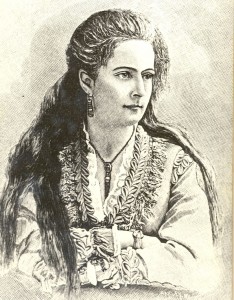 February of 1866, Manuel Gonzalez converted the commanding officer’s quarters into a home for himself and his family. By then, the seedling had grown into a tree nearly a decade old. After they moved west of the fort to homestead the land that is now called Manuel’s Trace (behind Fort Myers High School), Manuel and Evalina sold the house Capt. F.A. Hendry’s in-laws, the Laniers. The tree apparently thrived until 1910, when it was blown over by a storm. By then, Harvie and Florida Heitman owned the house, and Harvie propped the tree up, braced it, and life went on. But the tree was so badly damaged by the hurricane of October 22, 1921 that it had to be destroyed. It was a
February of 1866, Manuel Gonzalez converted the commanding officer’s quarters into a home for himself and his family. By then, the seedling had grown into a tree nearly a decade old. After they moved west of the fort to homestead the land that is now called Manuel’s Trace (behind Fort Myers High School), Manuel and Evalina sold the house Capt. F.A. Hendry’s in-laws, the Laniers. The tree apparently thrived until 1910, when it was blown over by a storm. By then, Harvie and Florida Heitman owned the house, and Harvie propped the tree up, braced it, and life went on. But the tree was so badly damaged by the hurricane of October 22, 1921 that it had to be destroyed. It was a 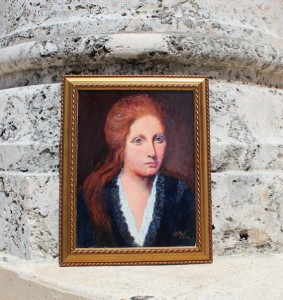 harbinger of things to come. Heitman had stomach cancer and died the following April 17 at just the age of 49.
harbinger of things to come. Heitman had stomach cancer and died the following April 17 at just the age of 49.
Over time, memory of the tree and the girl it came to represent faded. But we know what Ada looked like because her father commissioned a celebrated artist by the name of B.F. Reinhart to paint her portrait. The painting shows a soft, sensitive-looking girl with clear, clean features, large blue eyes, high forehead and tresses that must have reached her waist. And now, thanks to Fort Myers artist Genie Witzel, people will not only be reminded that Ada Elizabeth Hancock was Fort Myers’ first daughter, they will have a beautifully-rendered face to go with her name and story.
Portrait of Marion Twiggs Myers
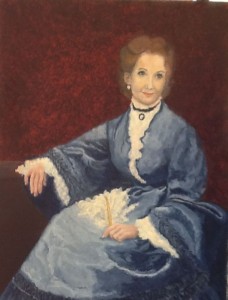 Witzel has also rendered a portrait for the Fort Myers Founding Females Portrait Exhibition of the town’s namesake, or to be more precise, the fiancée of the man for whom the fort that was built here in 1850 was named.
Witzel has also rendered a portrait for the Fort Myers Founding Females Portrait Exhibition of the town’s namesake, or to be more precise, the fiancée of the man for whom the fort that was built here in 1850 was named.
Marion Isabelle Twiggs met the Colonel Abraham C. Myers (5th picture down) in Texas, where her father was commander of federal forces. According to historian Karl Grismer, “[Myers’] dashing manner and merry smile won her heart.” Thereafter, Major General David Emmanuel Twiggs (4th picture down) took charge of the federal troops in Fort Brooke, with Myers becoming chief quartermaster of the Department of Florida. Abraham and 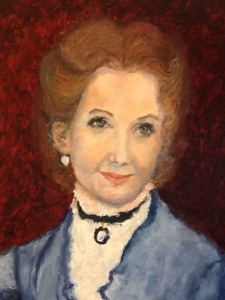 Marion continued their romance, becoming engaged. At the time, he was 39 and she but 13 years old. Apparently the General had no problem with the age differential, and when the War Department ordered Twiggs to re-establish a fort on the Caloosahatchee River, he mandated that the post be called Fort Myers “to honor his prospective son-in-law and please his daughter.” Interestingly, Twiggs issued those orders on Valentine’s Day, 1850.
Marion continued their romance, becoming engaged. At the time, he was 39 and she but 13 years old. Apparently the General had no problem with the age differential, and when the War Department ordered Twiggs to re-establish a fort on the Caloosahatchee River, he mandated that the post be called Fort Myers “to honor his prospective son-in-law and please his daughter.” Interestingly, Twiggs issued those orders on Valentine’s Day, 1850.
In Belles, Beaux and Brains of thel 60’s, author Thomas Cooper De Leon provides an illuminating account of Marion Twiggs Myers in the months preceding the start of the Civil War. “In all the mad rush that pre-bellum winter in Washington, 1860-1861, 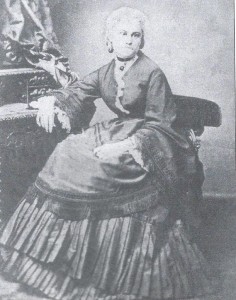 when grave heads shook ominously and light heels danced over a powder magazine and recked little when the fuse might reach, one handsome woman was constantly in evidence,” De Leon wrote near the turn of the 20th century. “Colonel A.C. Myers, of the quartermaster-general’s department, had married the brilliant and picturesque daughter of old General David E. Twiggs, of Mexican War fame. Grave and reticent as he was polished and accomplished, the husband was much older than his wife.”
when grave heads shook ominously and light heels danced over a powder magazine and recked little when the fuse might reach, one handsome woman was constantly in evidence,” De Leon wrote near the turn of the 20th century. “Colonel A.C. Myers, of the quartermaster-general’s department, had married the brilliant and picturesque daughter of old General David E. Twiggs, of Mexican War fame. Grave and reticent as he was polished and accomplished, the husband was much older than his wife.”
“[Myers] had as perfect a contempt for what he called society as his wife held delight in it,” De Leon continued. “[But he] was 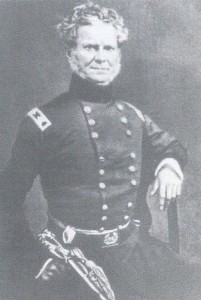 willing to let the young beauty dance and fritter the hours away at will. For several seasons prior to the war, she had been the reigning queen at Willard’s and a favored guest at every fashionable house. Her dancing was perfect, her tact equal to it and her beauty even more exceptional. Two pretty little girls were not too much in evidence, and the youthful mother enjoyed her freedom to the full.”
willing to let the young beauty dance and fritter the hours away at will. For several seasons prior to the war, she had been the reigning queen at Willard’s and a favored guest at every fashionable house. Her dancing was perfect, her tact equal to it and her beauty even more exceptional. Two pretty little girls were not too much in evidence, and the youthful mother enjoyed her freedom to the full.”
However, her days as a Washington socialite ended when Colonel Myers resigned his commission in the United States Army following the start of the war. He was appointed quartermaster general of the Confederate States Army in February of 1862. “Very valuable service he rendered, too, and the regular uniform adopted by the war department 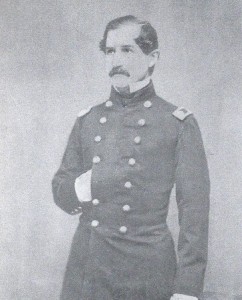 was, in larger part, of his design,” stated De Leon. But while her husband was busily requisitioning the supplies needed for war, Marion departed Richmond for Europe, where “her grace and beauty made the same impression as they had done in the older capital.”
was, in larger part, of his design,” stated De Leon. But while her husband was busily requisitioning the supplies needed for war, Marion departed Richmond for Europe, where “her grace and beauty made the same impression as they had done in the older capital.”
At some point, Marion returned to war-ravaged Virginia. It is unclear whether she came back with an attitude or her detractors influenced the way she is remembered today. In either case, it does appear that Marion played a role in her husband’s ensuing fall from grace within the Confederacy.
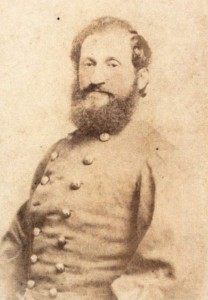 Myers basic responsibility as quartermaster general was to keep the Confederate army properly clothed and shod and he had at his disposal the Confederate Army’s largest supply bureau, complete with 88 clerks, quartermasters in each state, paymasters and quartermasters in the field, manufacturing plants, purchasing agents abroad, and depot and post quartermasters. But Myers was not able to obtain the clothing, shoes and other items that were needed because of the Union naval blockade coupled with lack of manufacturing in the South. Further, he was deprived of the leather he needed for shoes by the Ordinance Department , which inexplicably felt that leather cartridge boxes and harnesses for horses
Myers basic responsibility as quartermaster general was to keep the Confederate army properly clothed and shod and he had at his disposal the Confederate Army’s largest supply bureau, complete with 88 clerks, quartermasters in each state, paymasters and quartermasters in the field, manufacturing plants, purchasing agents abroad, and depot and post quartermasters. But Myers was not able to obtain the clothing, shoes and other items that were needed because of the Union naval blockade coupled with lack of manufacturing in the South. Further, he was deprived of the leather he needed for shoes by the Ordinance Department , which inexplicably felt that leather cartridge boxes and harnesses for horses 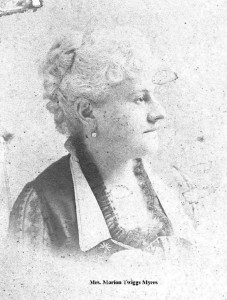 pulling artillery were more important than properly shod fighting forces. Nevertheless, it was Myers who took the brunt of growing complaints and Jefferson Davis finally removed him from command following the Battle of Gettysburg.
pulling artillery were more important than properly shod fighting forces. Nevertheless, it was Myers who took the brunt of growing complaints and Jefferson Davis finally removed him from command following the Battle of Gettysburg.
But Davis’ action may have also been motivated, in whole or in part, by a comment that Marion Myers made about Davis’ wife at a social gathering. According to several accounts, Marion ostensibly said that Varina Davis looked like “a old squaw.” The comment, said to be typical of the sharp-tongued Mrs. Myers, was only one salvo in a long war between these leading ladies of Richmond, and given the fact that Varina Davis had a dark 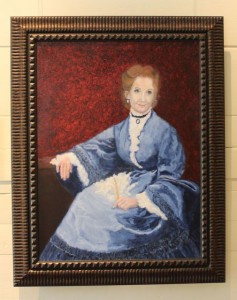 complexion and a generous silhouette, the remark was oft repeated, not forgotten and never forgiven.
complexion and a generous silhouette, the remark was oft repeated, not forgotten and never forgiven.
It also didn’t help that Abraham Myers was the great-grandson of Charleston’s first rabbi, a descendant of an old Jewish family that settled in South Carolina generations before the war. More than 10,000 Jews fought for the Confederacy and Robert E. Lee allowed his Jewish soldiers to observe all holy days, but this did not spare Lt. Col. Myers from suggestions that he enriched himself with his office, owing his first loyalty to “the party of Moses” and “the tribe of Levi.” Marion herself, in fact, was said to be from “the Lost Tribe” of Israel.
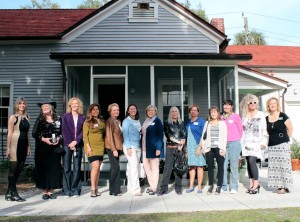 Blamed for losses on the battlefield and losing the war in the parlors of Richmond as well, Abraham Myers was replaced as Quartermaster General on August 10, 1863. Humiliated by his termination, Myers and Marion retreated to Georgia until the end of the war. They then relocated to Weisbaden, Germany, where they lived until 1876.
Blamed for losses on the battlefield and losing the war in the parlors of Richmond as well, Abraham Myers was replaced as Quartermaster General on August 10, 1863. Humiliated by his termination, Myers and Marion retreated to Georgia until the end of the war. They then relocated to Weisbaden, Germany, where they lived until 1876.
Although 26 years his junior, Marion outlived her husband by just four years. She passed in 1893. One of their sons, John Twiggs Myers, became a Lieutenant General and earned a place in Marine Corps history as commander of the American Legation Guard at Peking, China during the Boxer Rebellion. Interestingly, it does not appear that Abraham, Marion or either of their sons ever visited the city that today bears his name.
Portrait of Alice Hendry Tooke McCann
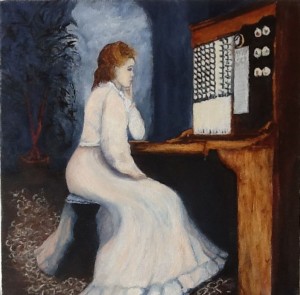 Witzel also painted Alice Hendry Tooke McCann for the Fort Myers Founding Females Portrait Exhibition. McCann served as Fort Myers’ first telephone switchboard operator. She first sat down to route calls for the Lee County Telephone Company on February 21, 1900. Working the day shift, she helped bring Fort Myers into a new century as she operated the six-circuit, 50-drop exchange above Heitman’s general store. When Sunday telephone service was added on January 18, 1903, she was entertained by the conversation
Witzel also painted Alice Hendry Tooke McCann for the Fort Myers Founding Females Portrait Exhibition. McCann served as Fort Myers’ first telephone switchboard operator. She first sat down to route calls for the Lee County Telephone Company on February 21, 1900. Working the day shift, she helped bring Fort Myers into a new century as she operated the six-circuit, 50-drop exchange above Heitman’s general store. When Sunday telephone service was added on January 18, 1903, she was entertained by the conversation 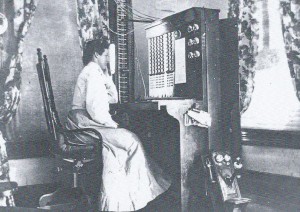 of courting lovers making dates for Sunday evening and spooning over the lines. Alice was also one of the women who helped Flossie Hill man the hand pump and save the business district from total destruction after the volunteer firefighters were overcome by exhaustion during the great fire of October 16, 1903.
of courting lovers making dates for Sunday evening and spooning over the lines. Alice was also one of the women who helped Flossie Hill man the hand pump and save the business district from total destruction after the volunteer firefighters were overcome by exhaustion during the great fire of October 16, 1903.
Alice was just a child when her sister, Esther Ann, 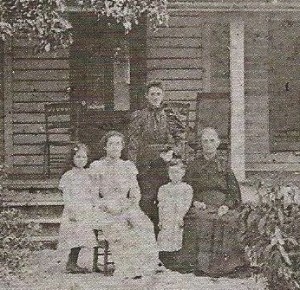 died at the age of six in the family’s 2-room frontier shack near Immokalee, prompting her mother, Jane L. Hendry, to move the family into Fort Myers. In the months that followed Jane and Charles Hendry’s arrival, Capt. F.A. Hendry and his brother, Marion, moved their families into town, converting Fort Myers from a nearly-deserted frontier settlement into a thriving cow town in the last quarter of the 19th Century.
died at the age of six in the family’s 2-room frontier shack near Immokalee, prompting her mother, Jane L. Hendry, to move the family into Fort Myers. In the months that followed Jane and Charles Hendry’s arrival, Capt. F.A. Hendry and his brother, Marion, moved their families into town, converting Fort Myers from a nearly-deserted frontier settlement into a thriving cow town in the last quarter of the 19th Century.













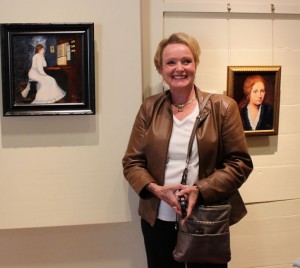

 Tom Hall is both an amateur artist and aspiring novelist who writes art quest thrillers. He is in the final stages of completing his debut novel titled "Art Detective," a story that fictionalizes the discovery of the fabled billion-dollar Impressionist collection of Parisian art dealer Josse Bernheim-Jeune, thought by many to have perished during World War II when the collection's hiding place, Castle de Rastignac in southern France, was destroyed by the Wehrmacht in reprisal for attacks made by members of the Resistance operating in the area. A former tax attorney, Tom holds a bachelor's degree as well as both a juris doctorate and masters of laws in taxation from the University of Florida. Tom lives in Estero, Florida with his fiancee, Connie, and their four cats.
Tom Hall is both an amateur artist and aspiring novelist who writes art quest thrillers. He is in the final stages of completing his debut novel titled "Art Detective," a story that fictionalizes the discovery of the fabled billion-dollar Impressionist collection of Parisian art dealer Josse Bernheim-Jeune, thought by many to have perished during World War II when the collection's hiding place, Castle de Rastignac in southern France, was destroyed by the Wehrmacht in reprisal for attacks made by members of the Resistance operating in the area. A former tax attorney, Tom holds a bachelor's degree as well as both a juris doctorate and masters of laws in taxation from the University of Florida. Tom lives in Estero, Florida with his fiancee, Connie, and their four cats.